A Big Pilot Fan’s Take on The New IWC Big Pilot’s Watch 43
IWC says that size matters... And for the Big Pilot, it really does.
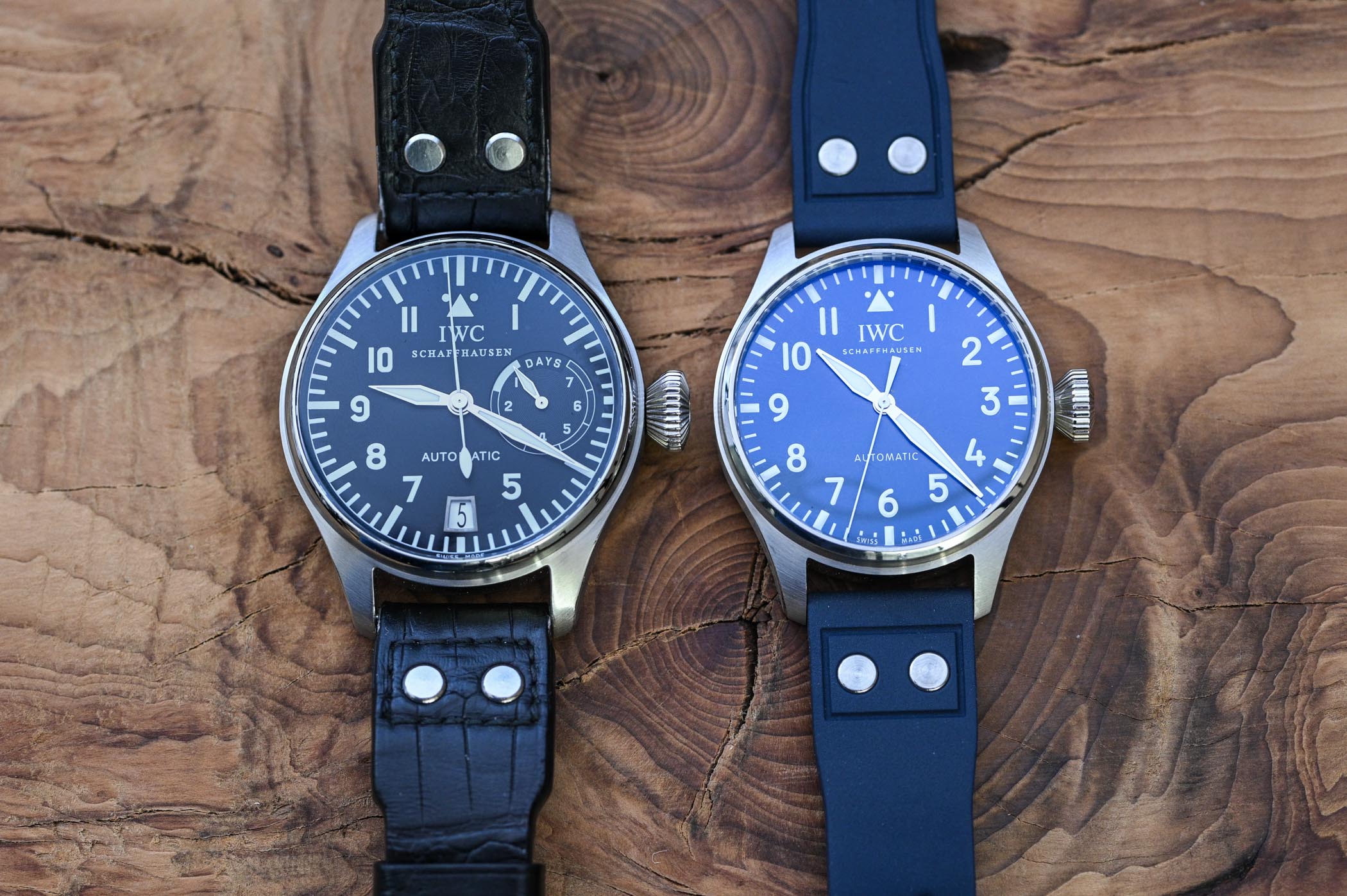
The Big Pilot… If you think about an emblematic, unmistakable watch by IWC, you hardly can do better than this. It is, at least to me, a watch that has defined the brand’s collection for years, a proper statement watch that is, and remains after close to 20 years of production, one of the best known modern watches. Having said that, you’ve probably guessed that I love the IWC Big Pilot… I’m in the fortunate position that I can also say that I own a Big Pilot ref. 5002 (the first-generation model). Thus, when IWC introduced earlier this year the new, smaller, downsized, ‘streamlined’ Big Pilot’s Watch 43, it came to me as serious news. There was more than just a new watch to it, but also something to do with the actual name of the watch. Now that I had the chance to have one of these 43mm watches in the office for a review, it’s time to tell you what I, as a Big Pilot fan, think about this new watch.
The history of the IWC Big Pilot
Before we even move to modern references of the Big Pilot’s watch, we have to look back at IWC’s history. Like many manufactures in the late 1930s and early 1940s, IWC had to participate in War effort strategies for most forces in Europe. As such, the Schaffhausen-based company developed numerous watches destined for pilots and aircraft crew members. Although it all started in 1936 with the IWC “Special Watch For Pilots”, the most recognisable watch in this field is the 1940 Big Pilot’s Watch Calibre 52 T.S.C. (reference IW436).
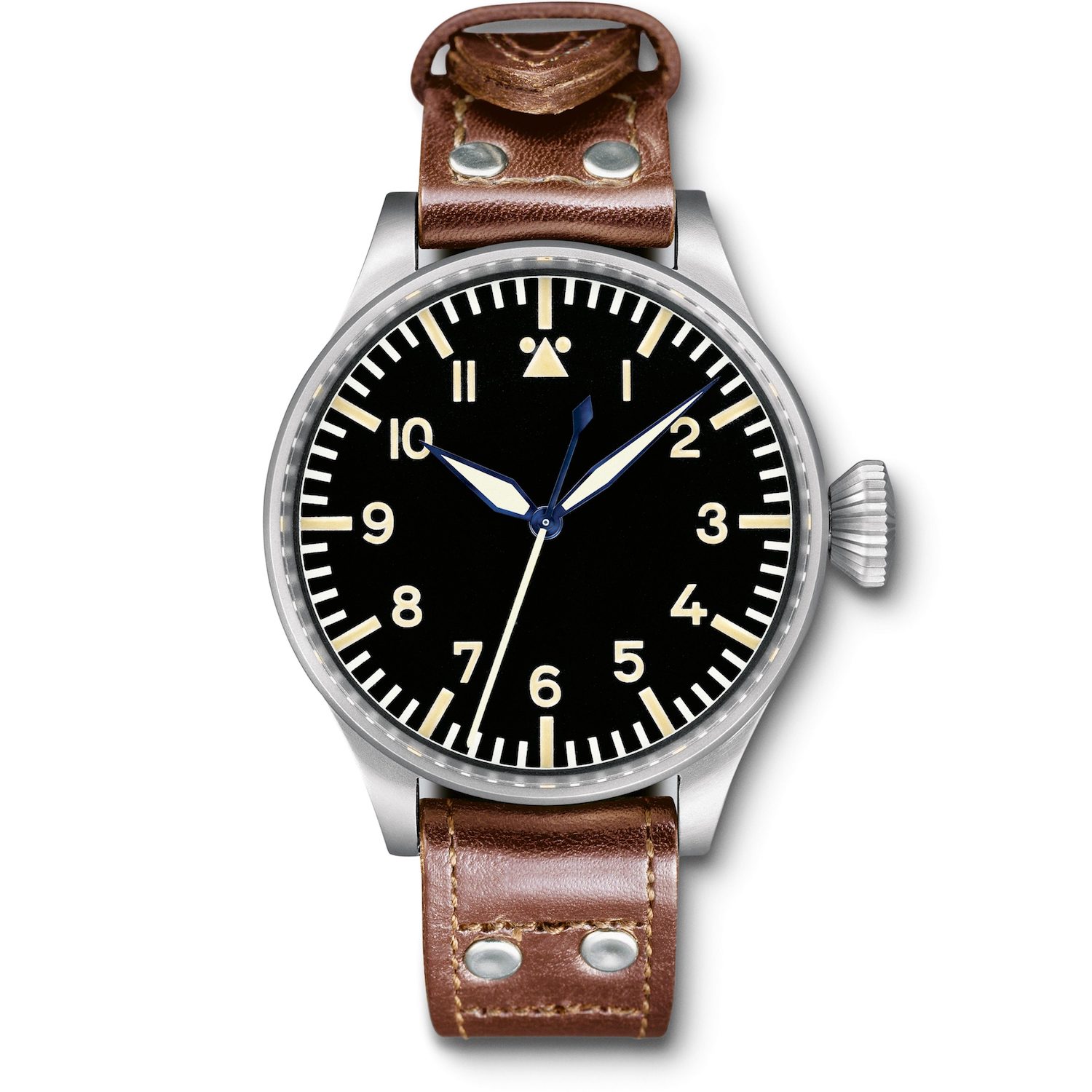
A behemoth of a watch supplied to the Luftwaffe (the German Air Force) in 1940, it was classified as an observation watch and produced in a run of around 1,000 pieces. Its case measured 55mm in diameter, and its dial was instantly legible with oversized luminous hands and markers. It was equipped with large Arabic numerals and a triangle with two dots, to help spot the 12 o’clock position in the dark. Inside was a reliable and highly precise pocket watch movement. Following the end of WWII, the production of these watches stopped, although their famous design perdured.
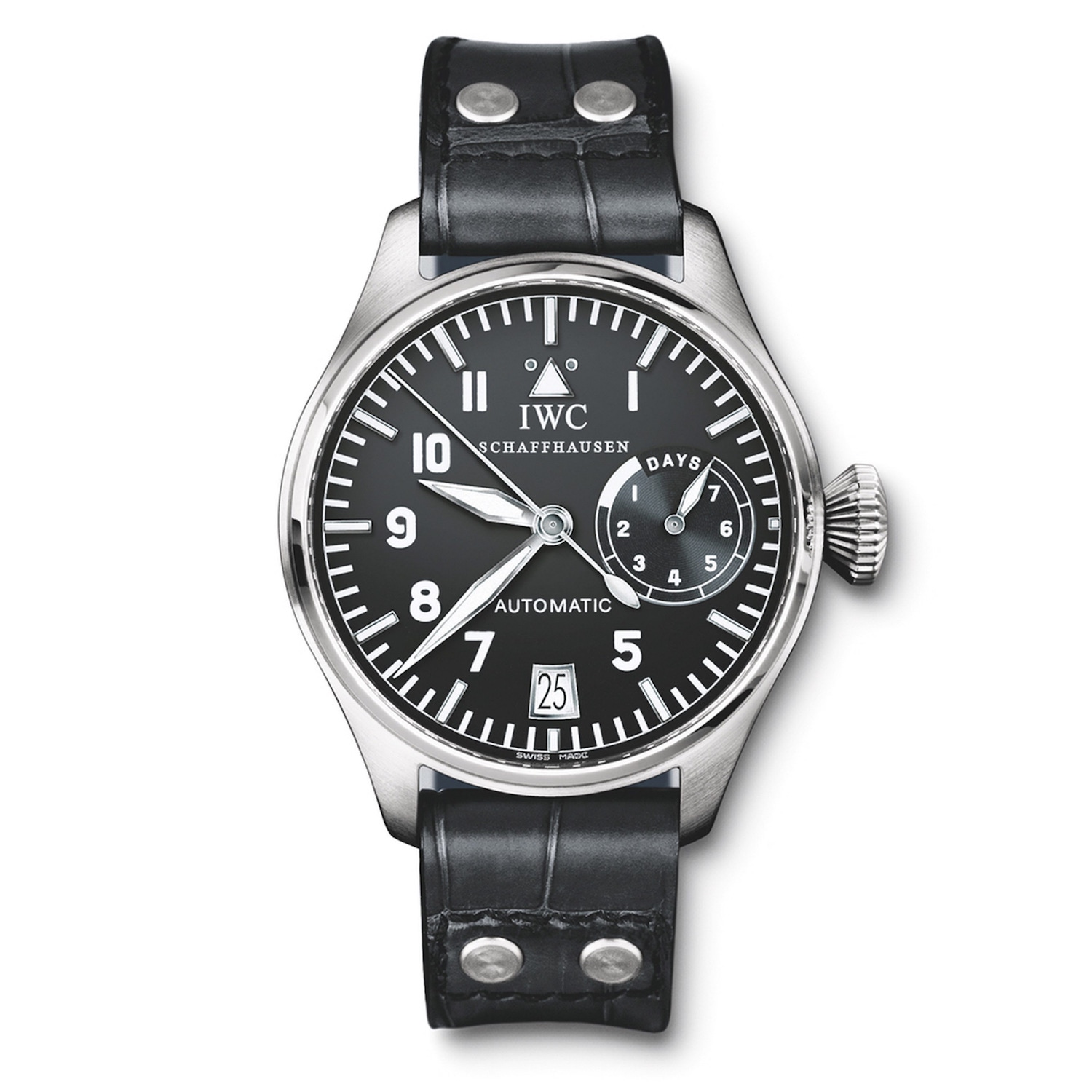
In the early 1990s, IWC (re)launched the Pilot’s Watch collection with the Mark XII and several Flieger chronographs. It took quite some years before the brand decided to revive the concept of the observation watch, an oversized, ultra-legible, ultra-precise watch with all the distinctive elements of the “B-Uhr” models. In 2002, IWC took its new ultra-powerful automatic movement (found in the Portugieser automatic), changed it to a central seconds display, and produced a modern interpretation of the observation watch. Named the “Grosse Fliegeruhr” or Big Pilot’s Watch, the model (IW5002) was smaller but no less imposing at 46mm. Except for the date and the power reserve display, its dial was a faithful tribute to the B-Uhr watches. The original ref. 5002-01 was replaced in 2003, with a transitional model featuring the exact same looks and an improved movement with a higher beat rate (and a different crown, now engraved with the brand’s motto Probus Scafusia instead of the original ‘fish crown’.)
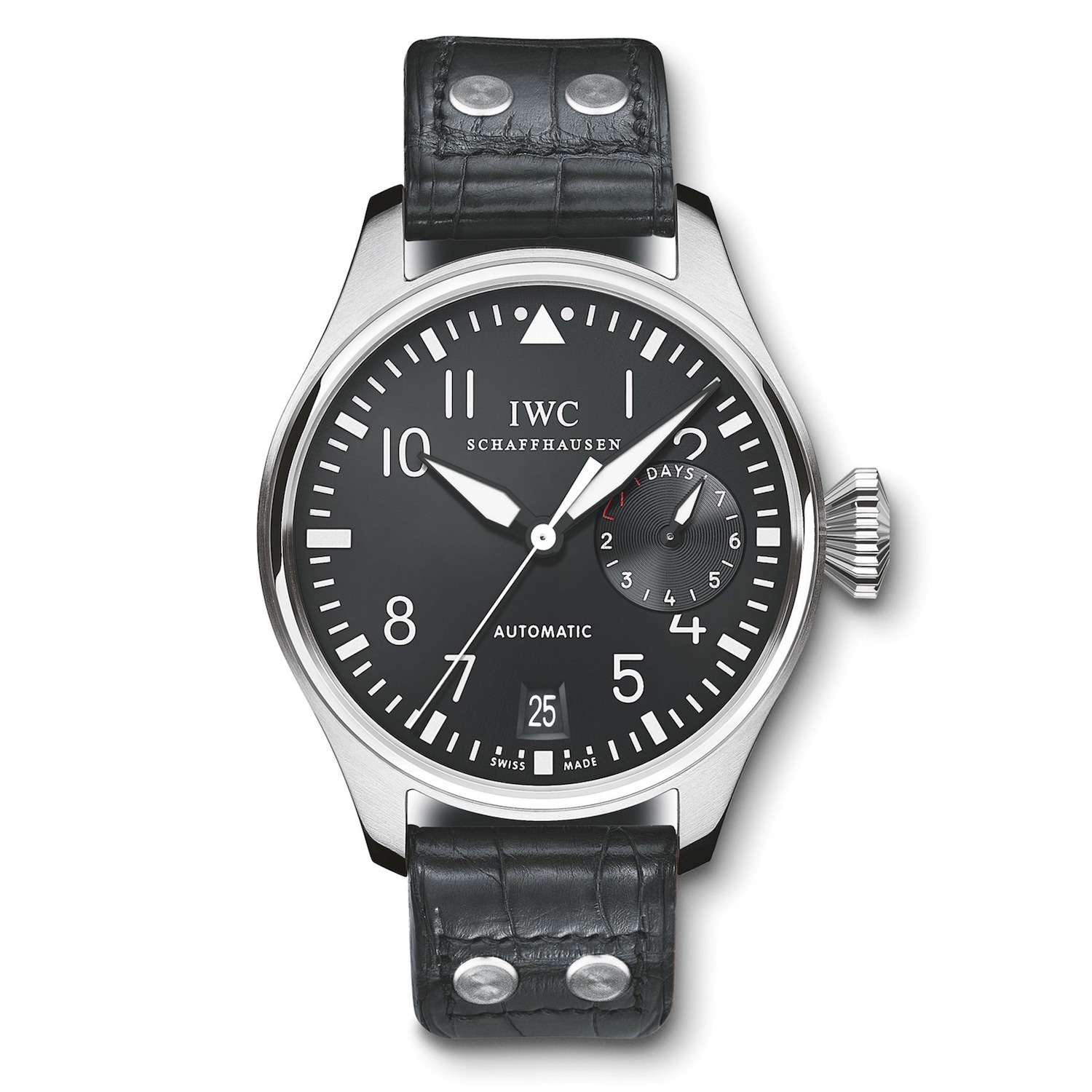
In 2006, the Big Pilot’s Watch was subtly redesigned, as reference IW5004. The numeral 9 on the dial disappeared, and now numerals at 2 and 4 o’clock on the dial were partially cut off. The dial of ref. 5004 was entirely painted, without applied indexes anymore. The strap was upgraded from buffalo to alligator. The movement was improved, but remained at 3Hz; first calibre 51110 in 2005/2006 and then calibre 51111 as of late 2006. In 2012, some improvements were made on the crown and stem-sealing system, and the Big Pilot watch became reference IW5009. Finally, the Big Pilot’s Watch was further improved in 2016 when it was given a new movement, calibre 52110, under the reference IW5010. Some small updates were also applied to the dial (including the return of number “9”.)
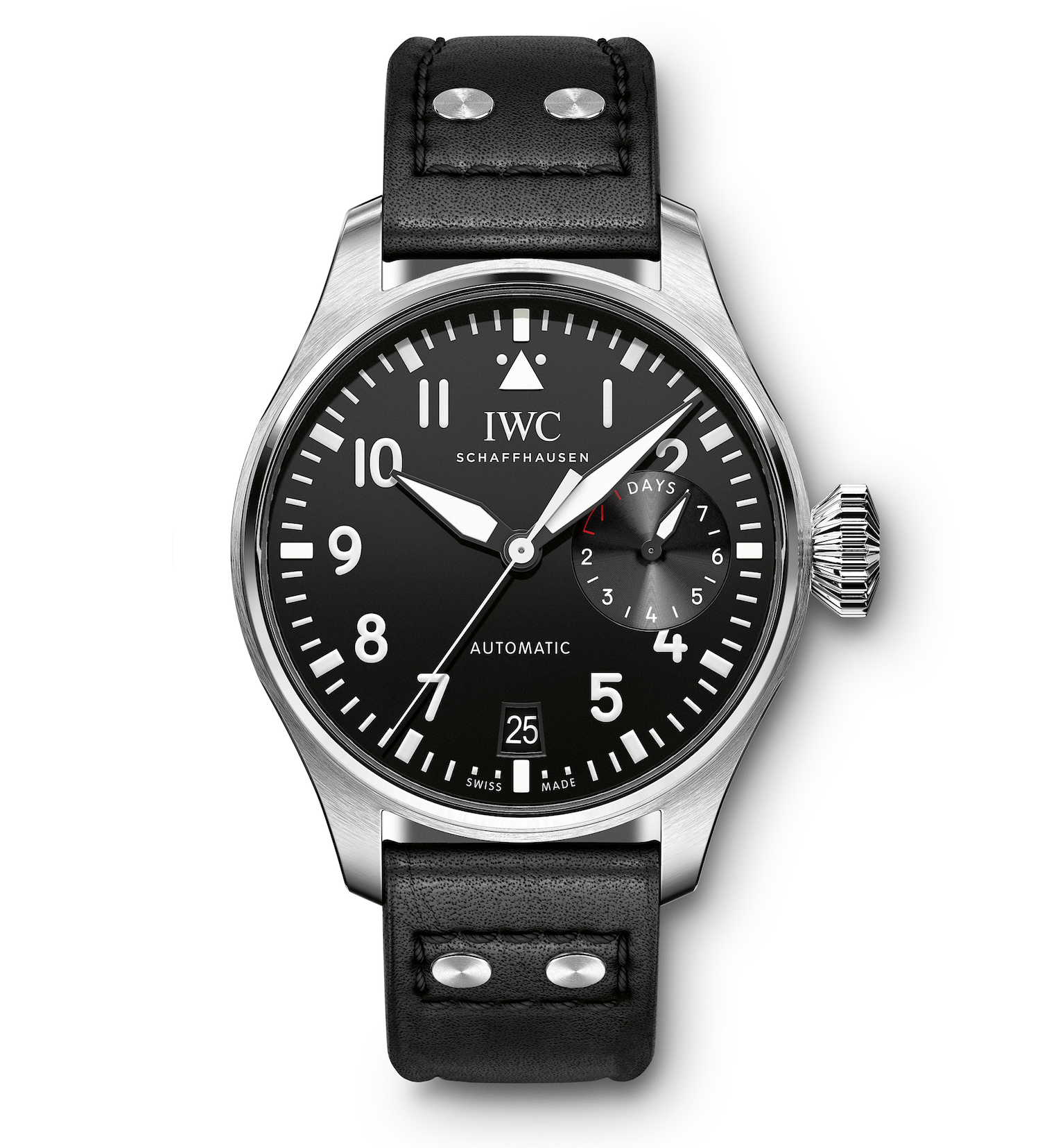
Some unmistakable, iconic features – during all its years of production, certain things remained true for the Big Pilot’s Watch. First, its oversized diameter of 46.2mm – or even more on some editions – the presence of a date window at 6 o’clock, an ultra-large automatic movement with a 7-day power reserve and a power reserve indicator at 3 o’clock. These elements are, to me, signature design and technical features that are part of the model’s design. It’s not only a matter of size, it’s also a matter of display and mechanics. Size does matter. So, let’s have a look at the new IWC Big Pilot’s Watch 43.
The IWC Big Pilot’s Watch 43
Smaller, slimmer, more focussed… there’s a new member in the BP family and it’s named the IWC Big Pilot’s Watch 43. We’ve already presented the watch in an extensive article here, which even included a video review. But let me go back to the basic specifications before the all-important answer to the question “is the Big Pilot’s Watch 43 a true Big Pilot?”
First of all, the BP43mm doesn’t replace the original Big Pilot’s Watch (which is now known under the reference IW501001.) The new, slightly ‘less big’ Pilot’s Watch comes as an additional member of the family and is here to please a new target audience. It is a less hardcore, slightly more consensual, more accessible (and not only financially) and more daily-oriented version of IWC’s pilot’s watch. If you want the taste of the original Big Pilot, you’ll still have the opportunity to acquire one.
One of the main updates concerns the size of the case, which now measures 43mm in diameter, 13.6mm in height and about 53mm lug-to-lug. By no means a small watch, it is on the other hand significantly smaller than the original BP, which is about 3mm larger everywhere (46.2mm x 15.5mm x 57mm). The stainless steel case of the BP43 is classic, totally in line with the rest of IWC’s pilot’s collection, with a diamond-shaped crown, large shoulders, an ultra-thin bezel that raises above the case and a combination of brushed surfaces and polished accents, the latter being found on the bevels of the lugs and on the bezel. There are, however, certain great additions to the case, such as the water-resistance that is now rated at 100 metres. On the other hand, the inner soft-iron case has gone since the watch is equipped with a screwed case-back with a sapphire window. This might already give you an indication of the vocation of this Big Pilot’s Watch 43.
The dial of this smaller BP43 watch comes without surprises. Just like the case, the connection with the rest of the brand’s pilot’s watches is undeniable and it features all the expected signature features. This means an ultra-wide dial that is entirely focused on legibility. I mean, you hardly can beat the crispness of this dial, both night and day. The contrast is superb, the markers are wide and largely filled with Super-LumiNova, the hands are oversized and adequately stretch to the markers. As for the design, the classic rounded Arabic numerals are taken from the recent editions of the Big Pilot’s Watch and the same goes for the shape of the triangular marker at 12 o’clock and the hands. You’ll be in known territories.
The watch I had with me for this review was equipped with the slightly more modern blue dial, with its sunray-brushed pattern that offers nice reflections and a less strict look than the classic matte black dial. You can’t go wrong with either option, yet the blue edition is different, less traditional. Other than that, there’s nothing to this dial worth mentioning. No additional feature, just 3 hands and a very limited amount of ‘literature’.
When it comes to the movement, IWC is here applying the same recipe as what was done a few years ago with the Portugieser 40mm. The original Portugieser Automatic, with a 42mm case, is powered by the large 7-day power reserve automatic movement, the same as found in modern editions of the Big Pilot’s Watch. For the BP43, IWC relies on a simpler yet more modern automatic calibre, the 82100. This movement has been conceived to be a replacement for outsourced movements, with multiple improvements over these. The automatic winding is done by the brand’s Pellaton winding system, the power reserve is a comfortable 60 hours, and the movement measures 30mm in diameter, making it better adapted to contemporary sized watches, especially on the BP43 that features a see-through case-back. It is also quite pleasantly designed with opened bridges that reveal most movement parts. The decoration, if industrial, is well executed and simply looks quite appealing. Finally, some components like the automatic wheel or the pawls that mesh with it are made of virtually wear-free zirconium oxide ceramic.
Fantastic versatility, with interchangeable straps/bracelet and deployant buckle
One part of the new IWC Big Pilot’s Watch 43 that truly deserves attention is the strap/bracelet. Let’s make it short, IWC has created one of the best interchangeability systems on the market, period! And that is one of the reasons why this new 43mm edition is so much more versatile than its bigger brother.
First of all, IWC now offers the ability to wear a Big Pilot’s Watch on a stainless steel bracelet, which itself is quite an event – it’s a first for this segment of the Pilot’s collection – and drastically changes the look of the watch. Like, really making it a whole new watch. Secondly, the conception of the bracelet itself is stunning. The narrow links are providing suppleness and comfort, the combination of brushed and polished surfaces makes the look smart and casual, and finally, there’s a greatly conceived clasp. Indeed, even though the clasp is quite compact (yes, that is a compliment), it comes equipped with a micro-adjustment system, meaning that you can extend its length by just pressing the IWC logo on the clasp. In addition, the buckle is fairly flat and well secured, with two pushbuttons. Well done IWC!
And then there’s the interchangeability system itself, which is one of the simplest to operate on the market. It is just a matter of “insert and click” with no tool required, or even no complex mechanisms on the back of the lugs or of the bracelet. See for yourself in our video below, as of 4min 06sec:
With this quick-exchange device in mind, IWC has also conceived a new range of straps. Besides the classic calfskin strap with rivets, which is available in black, brown or blue, or the stainless steel bracelet above, the brand has designed a new rubber strap that retains the classic pilot’s look with rivets, but that will make the new BP43 a much more summery watch, with even the ability to have a quick jump in the sea – which is now fully possible with its screw-in crown and 100m water-resistance. This rubber strap is available in black, blue or even in red for a bolder look.
Finally, the brand pushed the concept even further as not only changing the strap is super simple, but the same goes for the deployant clasp, which can be used either on the leather or rubber strap. This is, as far as I know, a world’s first and something that future owners will certainly appreciate a lot. Simply effortless. Again, well done, IWC!
The BP fan’s take on the Big Pilot’s watch 43
It is now time for me to become more critical, or at least, let’s say more opinionated. As I explained in the introduction, I am a real fan of the original “big” Big Pilot’s watch. I own myself a first-generation model, a reference IW5002-01 with the so-called “fish crown” and the slow-beat (2.5 Hz) 7-day power reserve automatic movement. This watch is part of the models that really made an impression on me when I started to get passionate about watches, and I have grown a sheer love for this watch.
Now, having the new IWC Big Pilot’s Watch 43 on my wrist, what do I think about it? In all fairness, this is a pretty impressive watch, it looks good, it has quite a bit of wrist-presence, and every is well-made! In fact, the more I think about it, I can only find one real ‘issue’ with it, which has nothing to do with the watch itself. Objectively, IWC has once again launched a watch that is superbly crafted, with an undeniable quality of construction. The case feels extremely solid, sharp in its finishing and neat when it comes to the assembly of the different parts. I really appreciate the upgraded 100m water-resistance and the possibilities to change straps, buckle and bracelet. The dial is crisp and flawless, even when looking at the smallest details. All the surfaces are pleasant to look at and to touch and the dial is exactly what you expect from an IWC Pilot’s Watch.
Also, even though the movement isn’t as advanced and powerful as the massive 7-day power reserve engine you’ll find in the classic BP, it remains a very well-engineered piece of horology that has a comfortable power reserve and that has been conceived with both precision and durability in mind. The skeletonized looks of the calibre 82100 are neat, and a real pleasure to observe through the case-back. And as said in the section above, the interchangeability system is top-notch and allows for great versatility.
With this edition, the Big Pilot has become easier to the wrist and to the eye. It is meant to be a watch that anyone can wear and enjoy, a watch that really has no significant flaw. The slightly more compact dimensions make it relatively easy to wear on a daily basis – even though in all fairness, it remains a watch with an impressive ‘wrist presence’. The absence of additional complications combined with the ability to wear it on a rubber strap or a stainless steel bracelet makes it more casual, slightly sportier. In short, it is a more mature, more reasonable and more versatile Big Pilot. And that’s where, at least in the eyes of a Big Pilot fan, things get a little more complex.
You see, the original Big Pilot has never been intended to be a versatile watch. It has never been made to be reasonable. When it was launched in the early 2000s, the Big Pilot was (and still is) a statement piece. It isn’t a watch that was designed to be a commercial success per se (even though it later gained great popularity). It was there to promote the rest of the collection as a showcase piece, a talking piece. It was meant to be demonstrative, overdone, slightly outrageous. Wearing a Big Pilot is something of an event. You don’t strap such a watch every day, or for any occasion. This demonstrativeness, this sense of sensational in the Big Pilot, even its impracticality, its weight, its visual impact, are all part of its charm. This eventfulness is what makes, among other things, a Big Pilot such an emblematic model.
And then comes the display. To me, and probably to many other collectors, the power reserve and the date window are two features that are essential in this watch’s design, as much as the oversized case. All of these elements combined, result in a watch that is and feels special, a watch that isn’t meant for a wider audience. This unconventional spirit is, to me, the raison d’être of the original Big Pilot.
With the BP43, I have a watch in front of me, that is sleeker, comes with only 3 hands, which is more casual, more versatile, easier to wear and meant to be on your wrist almost daily. Does that make the new Big Pilot’s Watch 43 a bad watch? Absolutely not. It is a great watch, with an undeniable sense of quality. And a very good looking one too.
And as a result, I think this watch doesn’t have the right name. The Big Pilot’s Watch 43 is, to me, a larger, more high-end, sportier version of the Mark XVIII. To me, it isn’t a Big Pilot. I know I might sound puristic, but these are just the feelings of a fan of the Big Pilot. Nothing wrong with the BP43, on the contrary, it just doesn’t come with the right name. Just like I wouldn’t accept a 3-hand Speedmaster, the chronograph being an integral element of its DNA, I want my Big Pilot to be sensational, unconventional, demonstrative, and with a very specific display.
Availability & Price
The IWC Big Pilot’s Watch 43 is now available from IWC boutiques, authorised retailers or IWC’s online boutique. Multiple editions are available, including a black dial with brown leather strap, a blue dial with blue leather strap or a blue dial with stainless steel bracelet. In addition, you can purchase a leather or a rubber strap, as well as the stainless bracelet as an accessory from IWC, and it will adapt to any model in the collection. The Big Pilot’s Watch 43 collection starts from EUR 8,850, CHF 8,900, USD 8,400 or GBP 7,200 which is about 45% less than a classic BP46 watch. That last piece of information might also change a lot the perception you’ll have of both watches…
For more details or to place an order, please visit iwc.com.

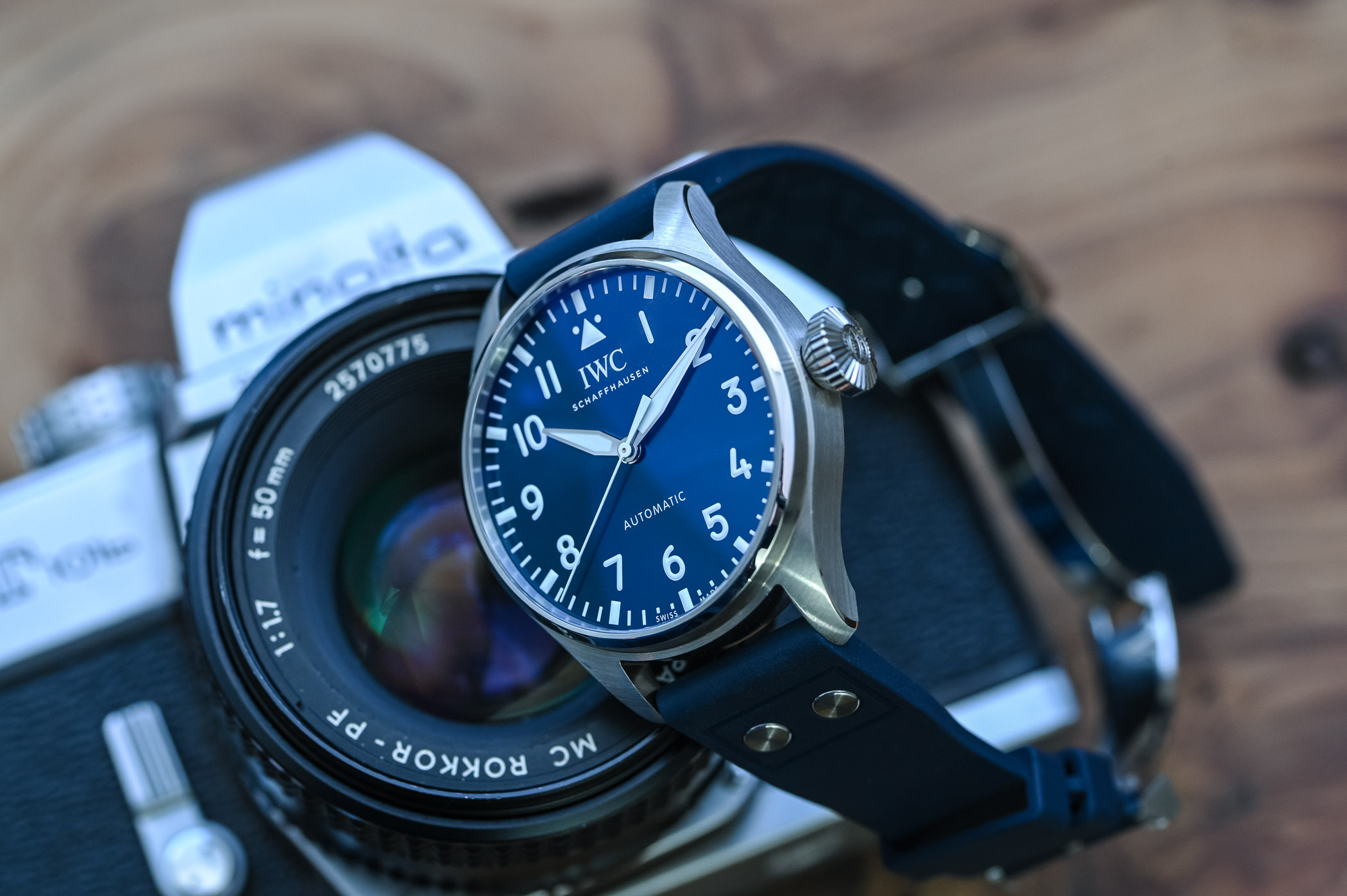
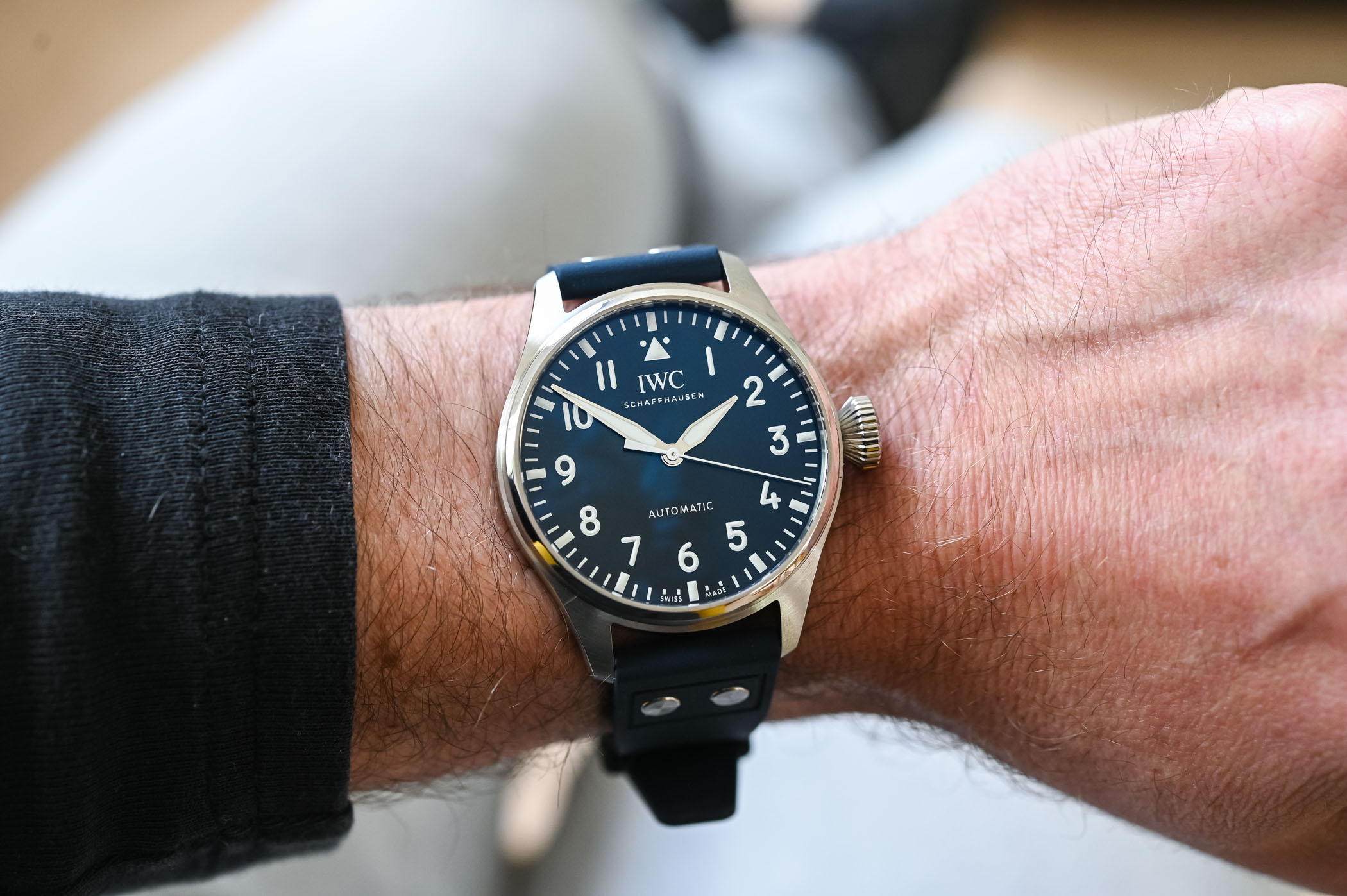
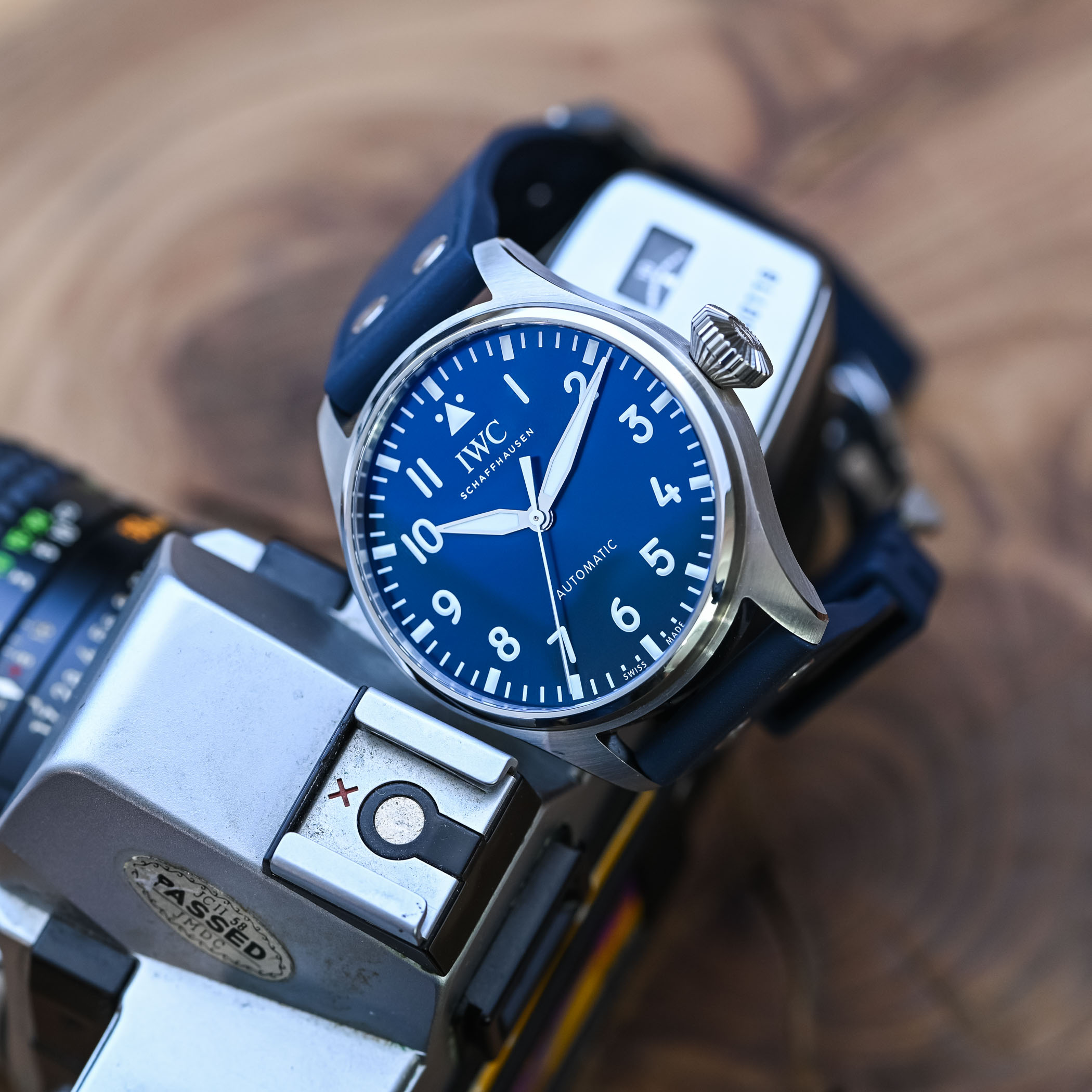
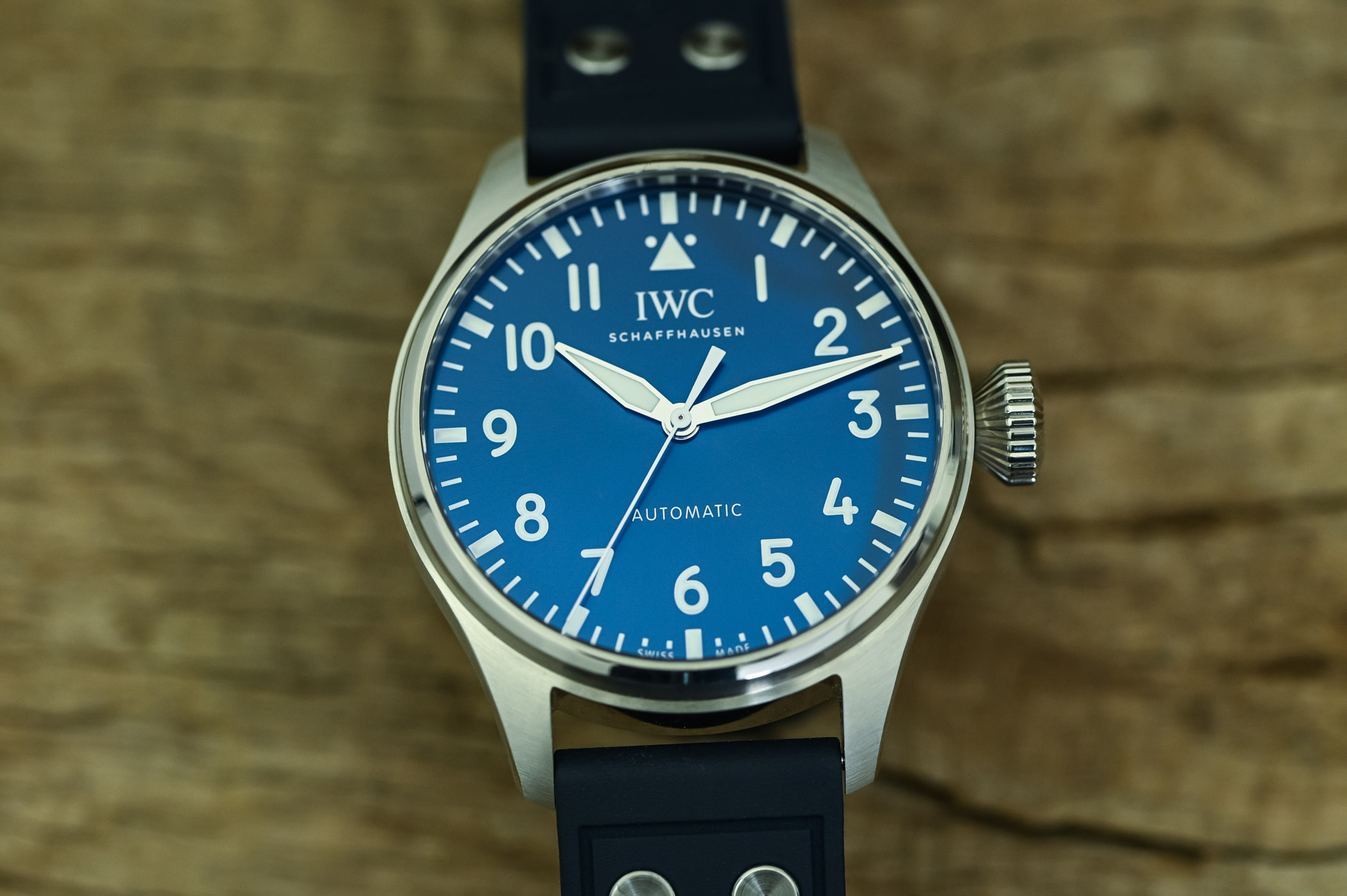



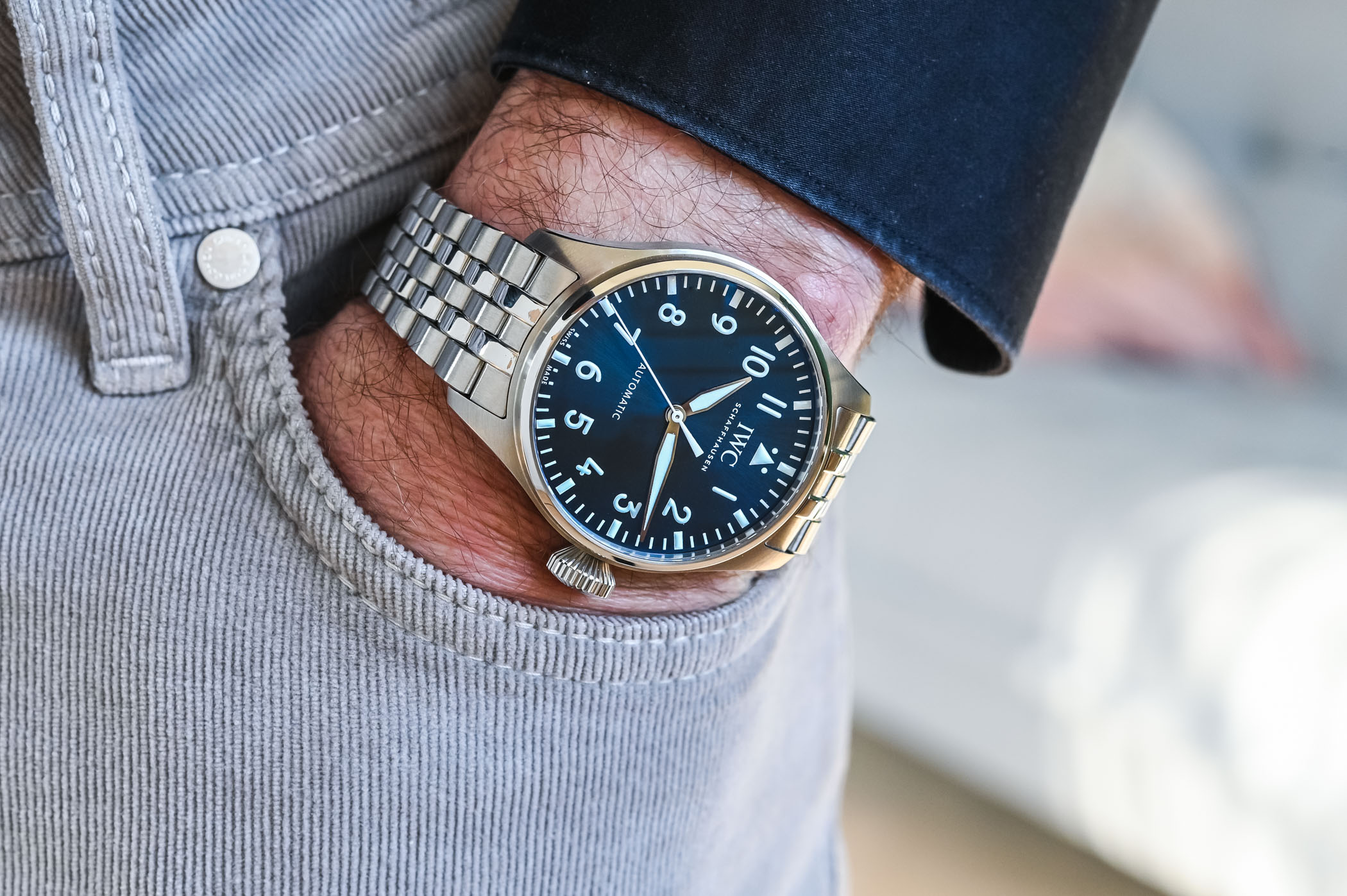
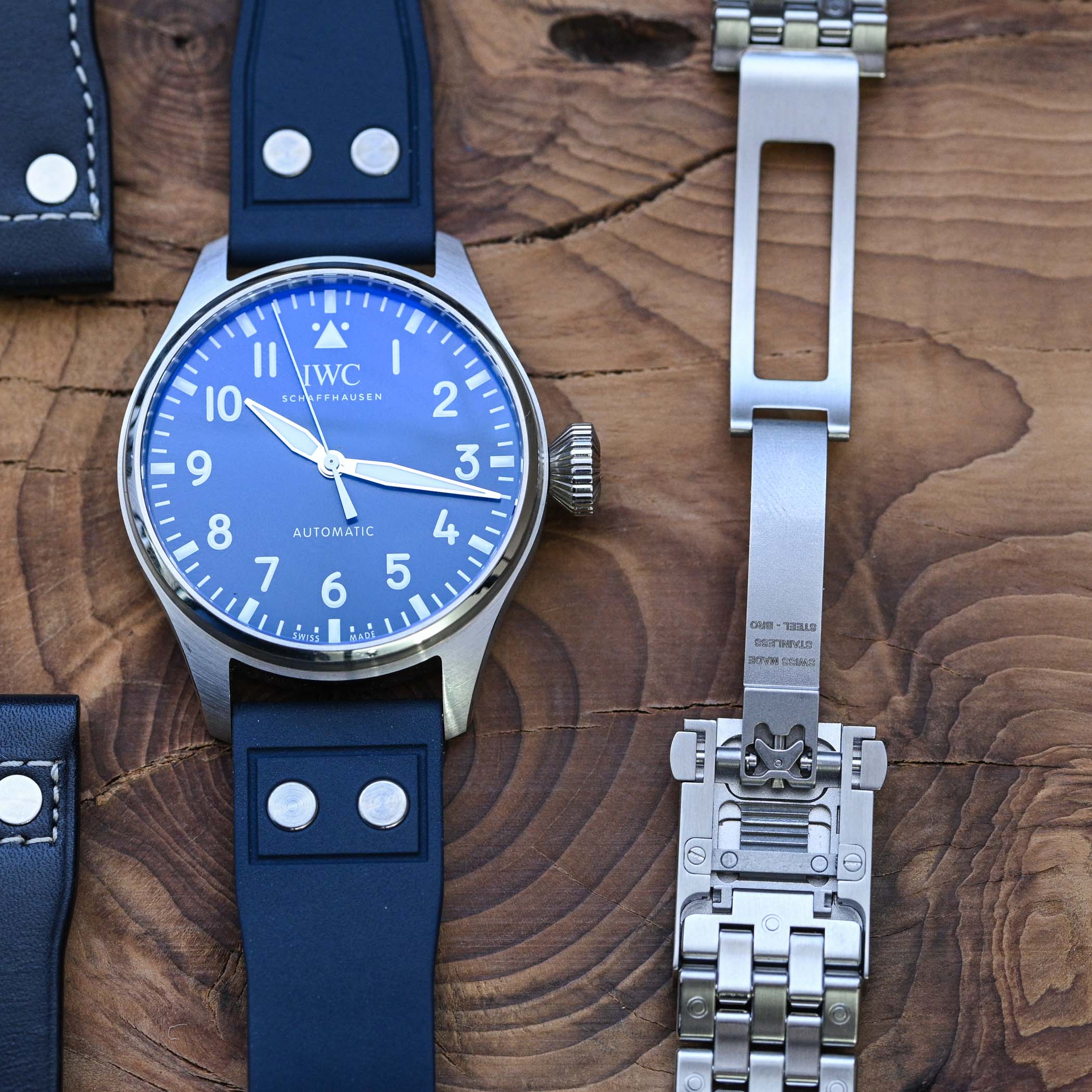
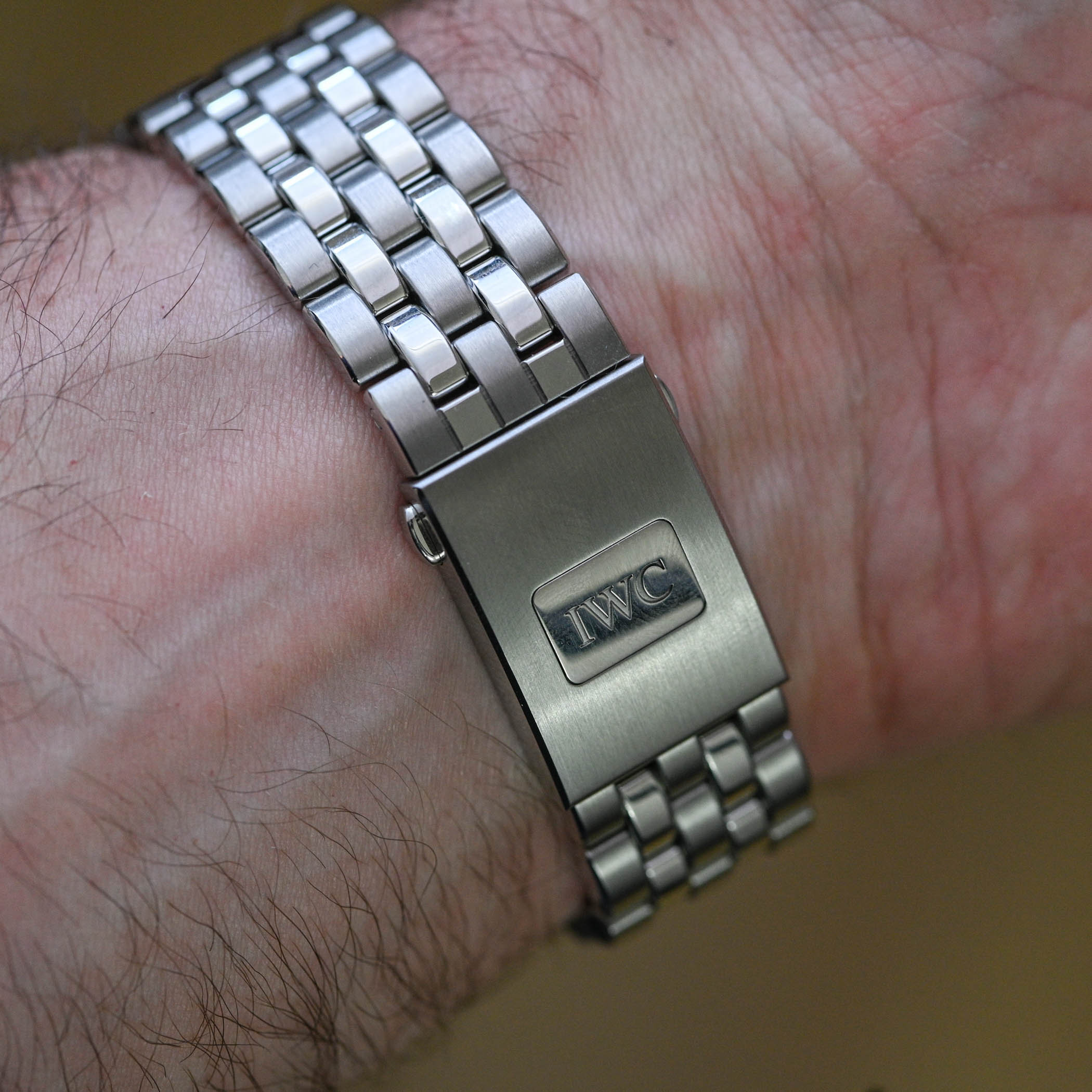
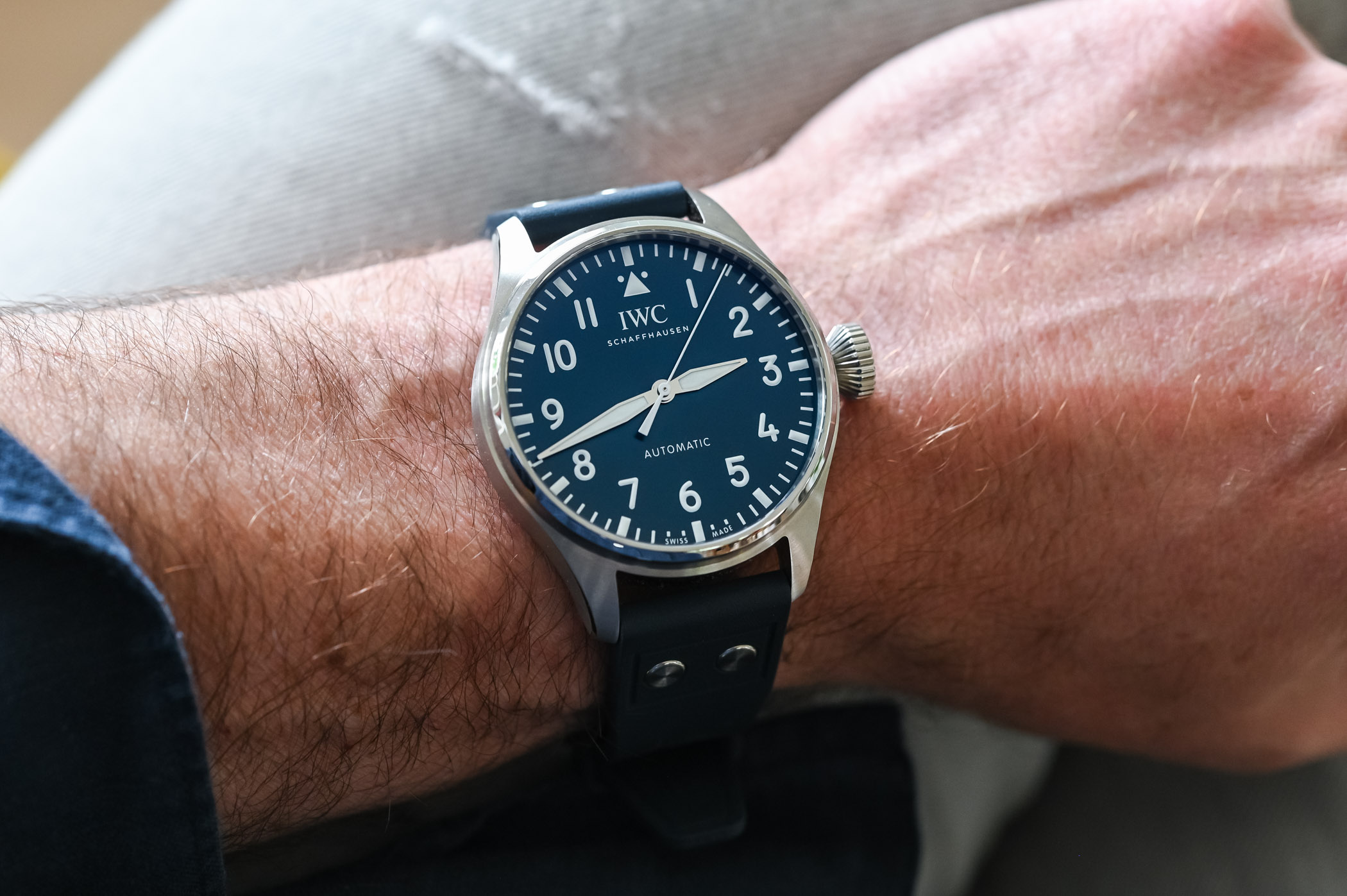
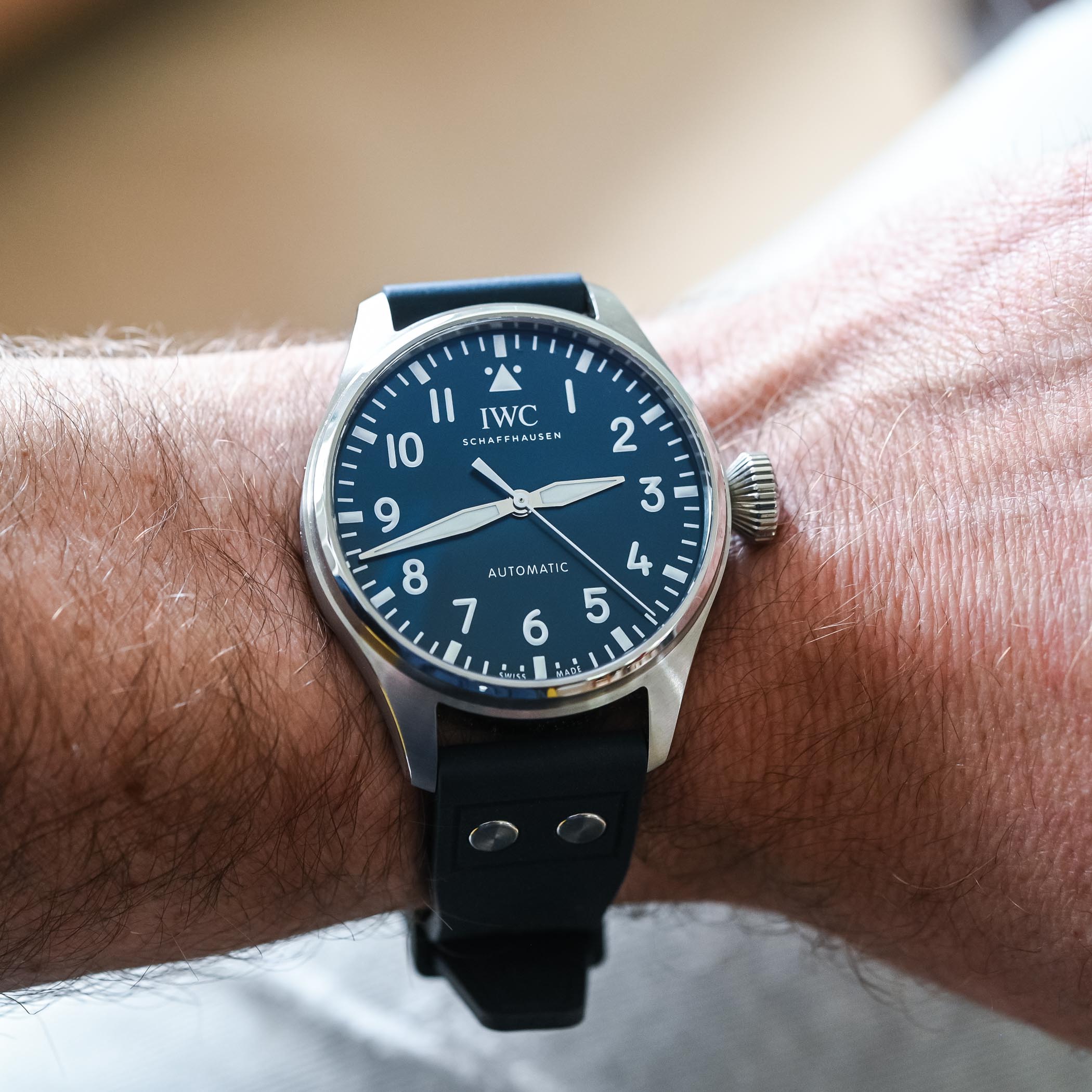
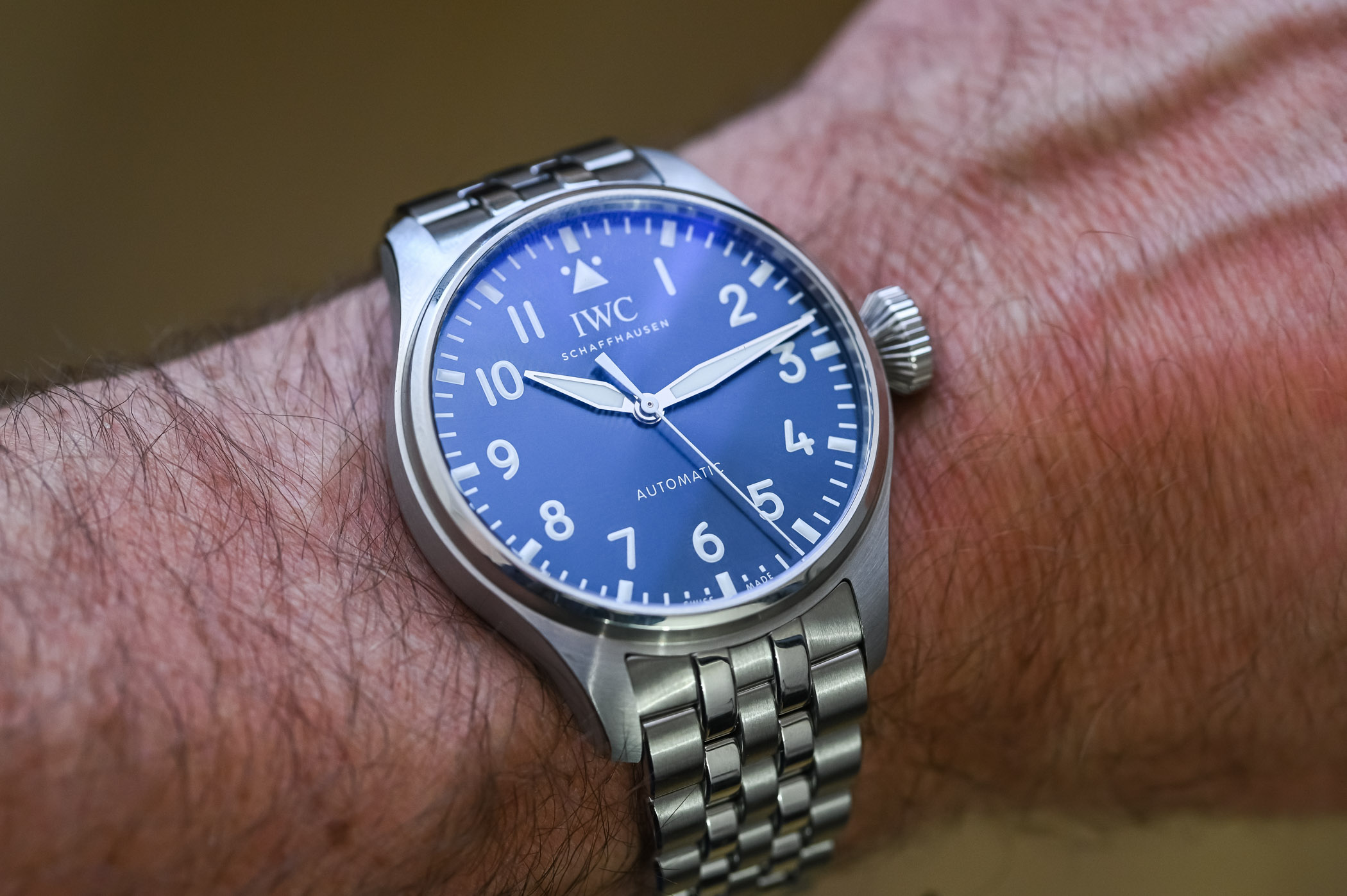
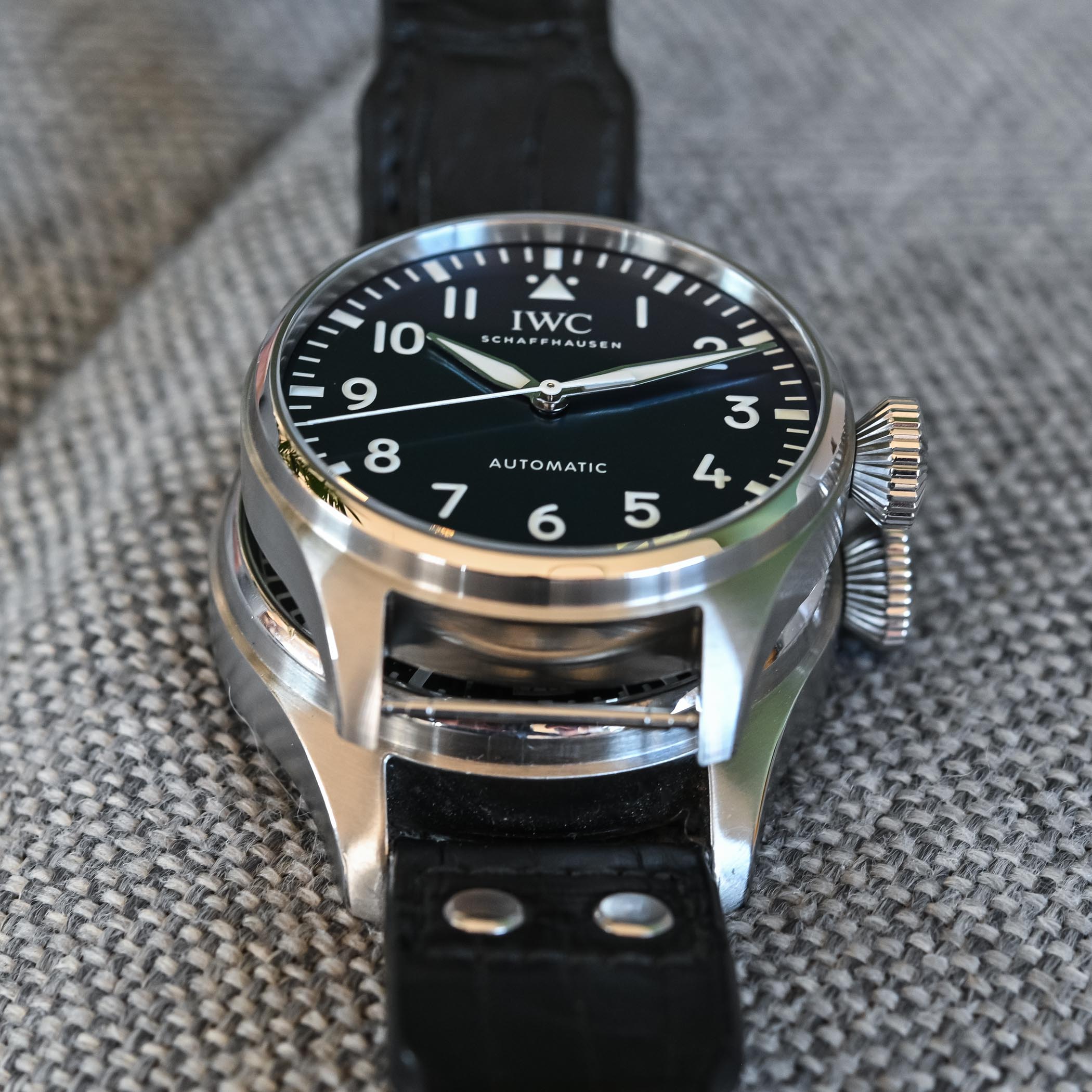
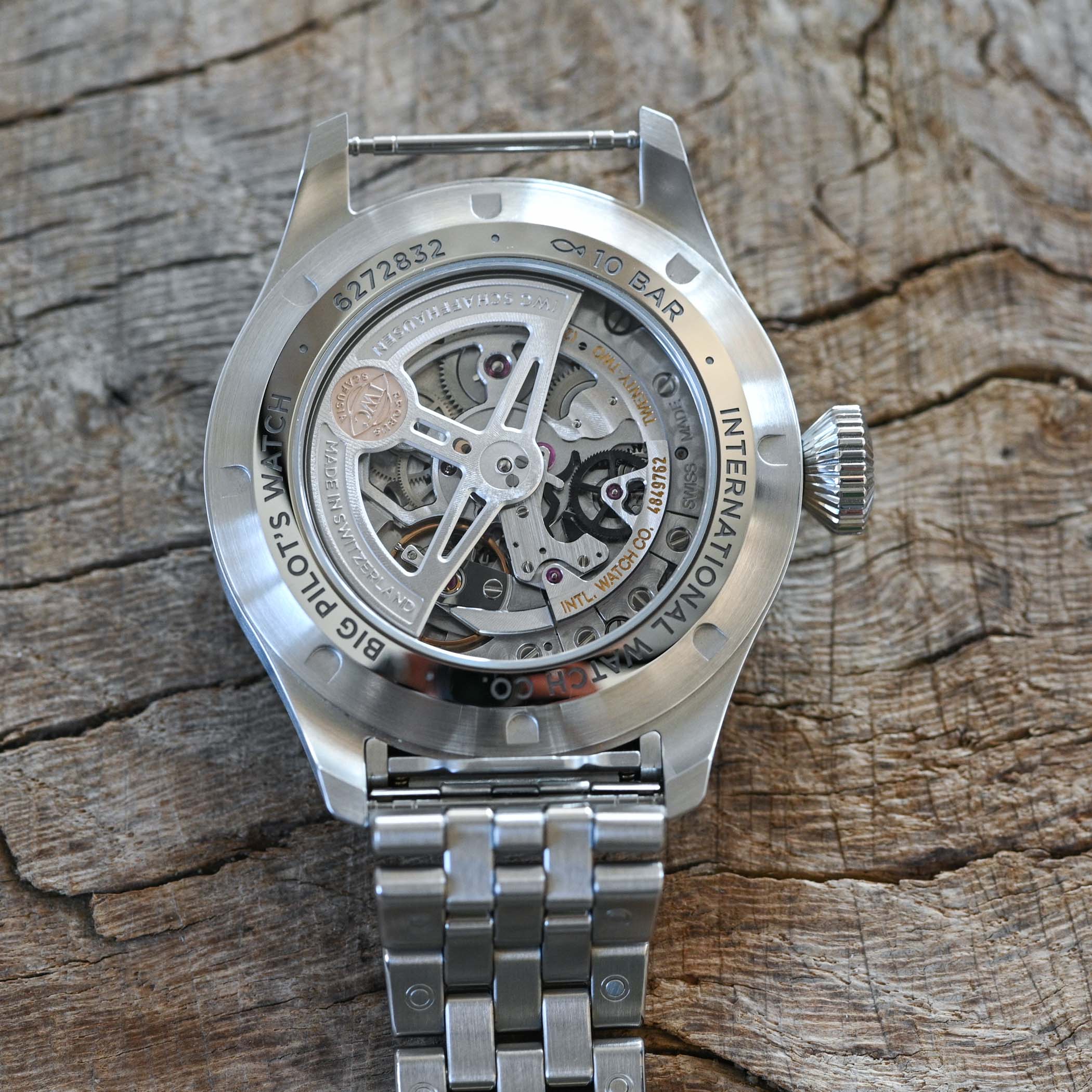

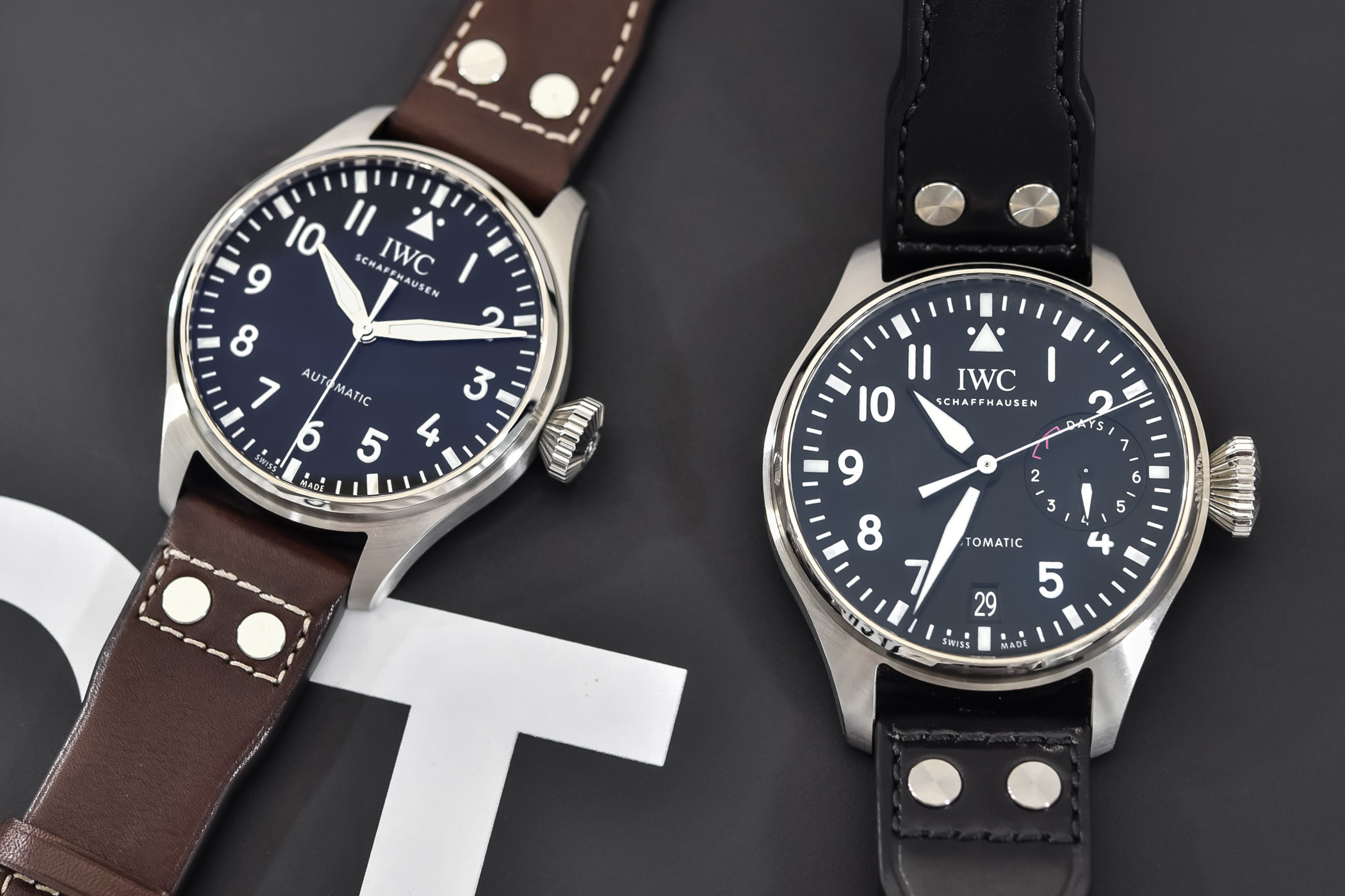
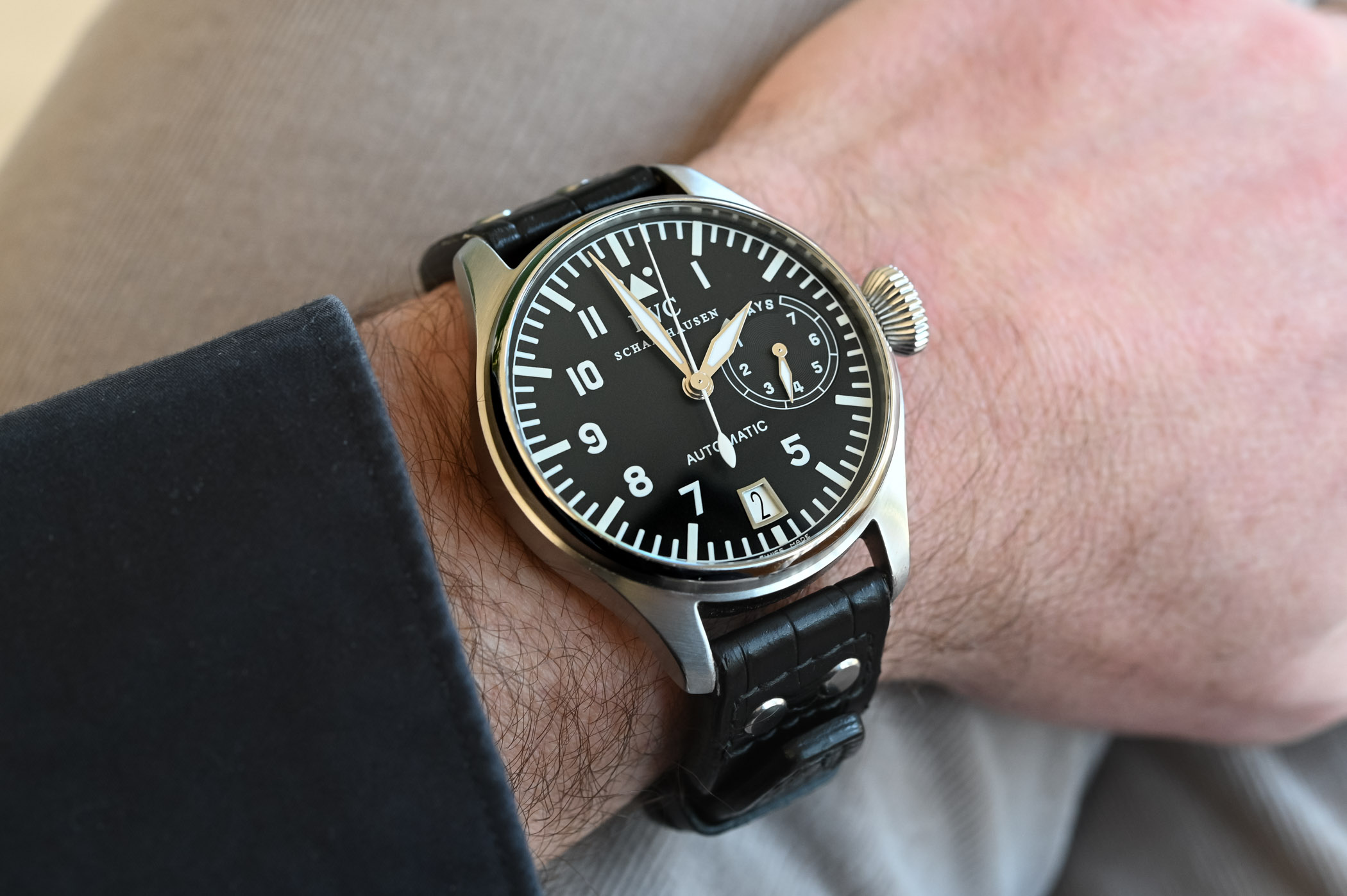

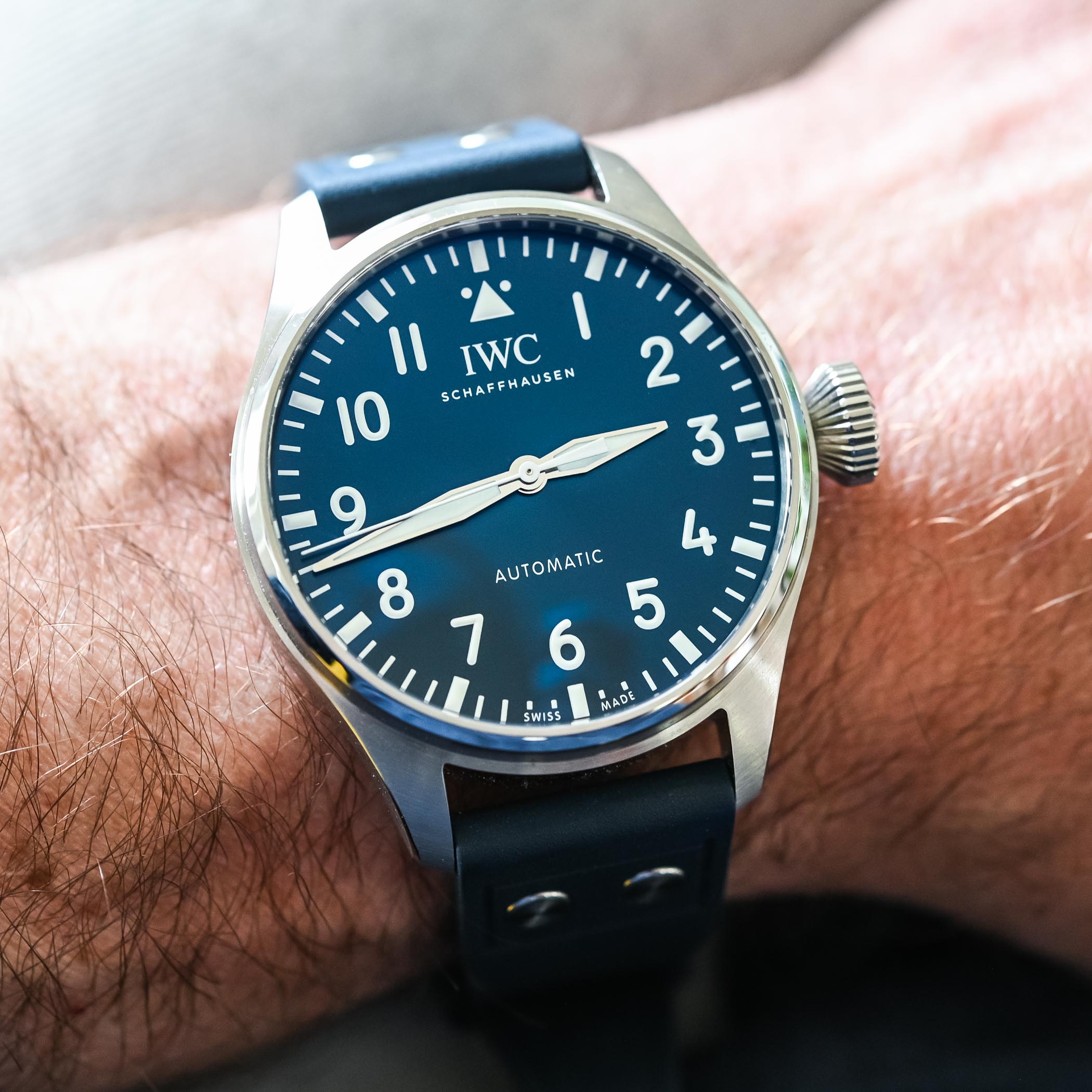



13 responses
Very refreshing to read an honest opinion, Frank, as well as seeing the continued use of ’emblematic’ instead of ‘iconic’, which as you know should be used sparingly 🙂
I’ve never really got into Pilots’ watches, a little chasm in my collecting focus – is there anything currently in production aside this (admittedly handsome IWC) that you might recommend I take a look at?
the 53 Lug to Lug kills it for me
@Gavin The Piot’s Watch bug has bitten me big time! But other than this collection, have you had a look at the Portugieser Rattrapante for the Milan boutique? The Portugieser Chronograph remains one of my favourites and the new Portugieser Perpetual 42 is also pretty nice. And I’m waiting for the Aquatimer collection to be upgraded!
@Jason… I can understand that very well. I admired the BP for a decade and a half, before finally pulling the trigger. And after trying it on my wrist many times, just to reassure myself that it’s wearable.
Gav, read about the history of the Beobachtungsuhr and pick some manufacturers to look into their current production.
Frank – get the motto right, it’s embarrassing…
@rp… just seen it was wrong, and now corrected. Thanks for pointing this out so kindly.
The BP 43 is neither fish nor fowl, imho. It’s lacking the 7-days-movement, the oversized case – and the system to change the strap is too much zeitgeist…
@ Frank – One hell of a watch, but a little complex dial-side. I think I’m like you (going from what I know of your collection) in that I appreciate a certain purity and simplicity, even when complicated. The only time I can recall being smitten by a pilot’s watch was seeing George Daniels’ 1948 JLC Mark XI when Roger Smith was interviewed about his collection a few years ago.
@ rp – Many thanks, I’ll disappear down that rabbit hole pronto!
@ Frank, agree with your comment re Mark XVIII. It just needs the crown to go with it. To me it is not a BP.
totally agree.
its a “big mark” instead of “big pilot jr”
Great article and insight. Pilot watches are just starting to catch my eye and I really enjoyed your refreshing opinion. The brushed blue dial is on point in my opinion. Cheers!
Size is relative. Is it big on you? I don’t agree with the “purist” comment because until people agree the 46 is not the same as the original 55, then they’re all smaller.
That 5002 you have is by far the nicest version, I wouldn’t change it for thr world. I’ve always loved BP’s, but been very anti the latest versions with half the 2 and 4 cut-out for the power reserve sub-dial, its an authentic design flaw that I just can’t live with. Love the clean uncluttered dial of the new 43mm and also love that the size is finally wearable on my smaller wrist size. But for so,e reason the new 43mm doesn’t really tugg at my heart strings the same way the older ones did.